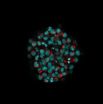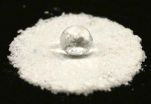(Press-News.org) Mobile phones, digital cameras, camcorders, notebooks: They all run on lithium-ion batteries. These are characterized by high energy densities while remaining small and light enough to be used in portable devices. "A lithium-ion battery can store three to four times the energy of a comparably sized nickel-cadmium battery," explains Dr. habil. Ralph Gilles, scientist at the Neutron Source Heinz Maier-Leibnitz (FRM II). Even temperature fluctuations and longer-term storage do not pose problems for lithium-ion batteries.
These advantages make lithium-ion batteries a key technology for electromobility. In the not too distant future, electric vehicles will be able to hold their own against liquid fuel-driven transport media – also with regard to the accessible distance. This will require powerful, safe and fast-charging batteries.
Lithium Plating Can Cause Short-circuits
However, one previously known, yet poorly understood phenomenon stands in the way of this goal: metallic lithium deposition or lithium plating, as it is called.
Simply put, energy storage in a lithium-ion battery works by the following principle: Both the positive electrode (cathode) and the negative electrode (anode) can bind lithium ions. During the charging process, the induced electrical field forces the ions to move from the cathode to the anode. When the battery is discharged, the lithium ions move back to the cathode, releasing energy in the process.
The cathode in lithium-ion batteries comprises a lithium metal oxide while the standard material for battery anodes is graphite (carbon) with a layered structure. During the charging process, the lithium ions are stored in these layers.
However, occasionally lithium ions form metallic lithium instead of intercalating into the anode, as desired. The lithium deposits onto the anode and is no longer fully available for the described process. The result is a drop in battery performance. In extreme cases this can even lead to short-circuits. In addition, metallic lithium is highly inflammable.
Non-destructive Investigation Using Neutrons as a Probe
Hitherto, observing the precise mechanism at work during lithium plating has not been possible. When a battery is opened, explains Ralph Gilles, you only get a snapshot of its present state. Yet, the amount of metallic lithium changes permanently. Using neutron beams, the scientists Dr. Veronika Zinth at the Neutron Source Heinz Maier-Leibnitz (FRM II) and Christian von Lüders at the Department of Electrical Energy Storage Technology were able to observe the processes inside of batteries without cutting them open.
"In contrast to other methods, with neutron diffraction we can make more precise statements about when and how strongly lithium plating takes place," explains Veronika Zinth.
Using the material research diffractometer STRESS-SPEC at FRM II, the researchers installed a battery, in both charging and discharging states, into the neutron beam. The incident neutron beam is diffracted according to Bragg's law and collected in a detector. Using these signals, the researchers were able to indirectly deduce how much metallic lithium had formed.
Faster Charging Means More Metallic Lithium
Initial results of the study:
The faster the charging process, the more metallic lithium is formed. Up to 19 % of the lithium ions normally involved in the charging and discharging process take on the metallic form. (The measurements were made at -20 degrees Celsius).
During a 20-hour resting phase following a fast recharge some of the metallic lithium reacts with the graphite, intercalating between the graphite layers as lithium ions. It is effectively a delayed, slow charging process. Albeit, only a part of the lithium plating is reversible.
Low temperatures encourage the formation of metallic lithium.
The scientists are planning further experiments to shed more light on the lithium plating mechanism. The results may help answer the question of how the phenomenon might be averted altogether. This will also involve answering the question of how quickly batteries can be charged before lithium plating sets in.
INFORMATION:
The study is part of the German Federal Ministry of Education and Research (BMBF) ExZellTUM (Exellence Center for Battery Cells) project. The ExZellTUM project is geared towards the development of new energy storage systems, as well as new manufacturing processes, forming strategies and test technologies for storage systems production. The project comprises four partners: the Department of Electrical Energy Storage Systems, the Department of Machine Tools and Industrial Management, the Department of Technical Electrochemistry and the Neutron Source Heinz Maier-Leibnitz.
Publication
Lithium plating in lithium-ion batteries at sub-ambient temperatures investigated by in situ neutron diffraction, Veronika Zinth, Christian von Lüders, Michael Hofmann, Johannes Hattendorff, Irmgard Buchberger, Simon Erhard, Joana Rebelo-Kornmeier, Andreas Jossen, Ralph Gilles, Journal of Power Sources, Doi: 10.1016/j.jpowsour.2014.07.168
Contact
Dr. Ralph Gilles
Technische Universität München
Neutron Source Heinz Maier-Leibnitz (FRM II)
Tel: +49 89-289-14665
ralph.gilles@frm2.tum.de
http://www.frm2.tum.de
Live from inside a battery
Researchers observe the phenomenon of 'lithium plating' during the charging process
2014-09-03
ELSE PRESS RELEASES FROM THIS DATE:
Rising risk of failed seasons as climate change puts pressure on Africa's farmers
2014-09-03
ADDIS ABABA, Ethiopia (2 September 2014)—Small-scale family farmers across Africa— already struggling to adapt to rapidly rising temperatures and more erratic rains—risk being overwhelmed by the pace and severity of climate change, according to the 2014 African Agriculture Status Report (AASR).The analysis, prepared by the Alliance for a Green Revolution in Africa (AGRA), with contributions from several African scholars, provides the most comprehensive review to date of how climate change will affect Africa's smallholder farmers and highlights the most promising paths to ...
Why HIV patients develop dementia
2014-09-03
Since the introduction of the combination anti-retroviral therapy (cART) in the mid-90s, the life expectancy of HIV patients has significantly improved. As a result, long-term complications are becoming more relevant: almost every second HIV patient is affected by neurocognitive disorders, which can lead to dementia. It has not as yet been fully understood how these disorders occur. Researchers from Bochum have now successfully demonstrated that infected cells activate specific immune cells in a patient's brain, which subsequently display harmful behaviour and lead to the ...
A fix to our cell-phone waste problem?
2014-09-03
When it comes to cell phones, the world is stunningly wasteful. Customers will buy more than 1.8 billion new ones by the end of this year only to abandon almost half of them to drawers, and they'll recycle a mere 3 percent of them. But creative and enterprising efforts are underway to reverse the seemingly unstoppable tide, says an article in Chemical & Engineering News (C&EN), the weekly news magazine of the American Chemical Society.
Alex Scott, a senior editor at C&EN, notes that there is much to be recovered and re-used from a cell phone. An average mobile contains ...
CNIO experts discover the genomic origin of telomere protectors
2014-09-03
RNA is one of the most primitive molecules associated with life that has awakened most interest over the last decade; a sister molecule to cellular DNA from which it originates via a process called transcription. Seven years ago, the groups of María Blasco at the Spanish National Cancer Research Centre (CNIO), Spain, and Joachim Lingner in Switzerland discovered that the DNA regions that contained telomeres, despite their compact and hard-to-access structure, generated RNAs that they christened TelRNAs or TERRA.
Now, a study published in the journal Nature Communications, ...
Breakthrough for carbon nanotube solar cells
2014-09-03
Lighter, more flexible, and cheaper than conventional solar-cell materials, carbon nanotubes (CNTs) have long shown promise for photovoltaics. But research stalled when CNTs proved to be inefficient, converting far less sunlight into power than other methods.
Now a research team led by Mark Hersam, professor of materials science and engineering and the Bette and Neison Harris Chair of Teaching Excellence at Northwestern University's McCormick School of Engineering, has created a new type of CNT solar cell that is twice as efficient as its predecessors. It is also the ...
Ethanol fireplaces: The underestimated risk
2014-09-03
Go to the DIY-market in the morning, buy the fireplace, and that evening, enjoy the cozy warmth and homey atmosphere of your new ornamental hearth. The suppliers of ethanol fireplaces are doing a brisk business with the lightweight, easy-to-install ornamental stoves with no chimney. However, caution is warranted when operating these fireplaces, because ethanol is a fuel that, together with the air, forms a highly combustible atmospheric mixture. If ethanol runs out when filling the combustion chambers and it ignites, then the entire room could go up in flames.
On top ...
Fingerprints for freight items
2014-09-03
Thousands of freight items are shipped by plane every day, around seventy percent of them in airliners. Stringent controls are supposed to prevent hazardous substances such as explosives from being smuggled on board. Screening procedures, such as x-ray scanning of freight, are time consuming and costly and have to be repeated in the event of suspicious circumstances. Easily verifiable features that verify that a freight item is "secure" have been lacking until now.
Researchers at the Fraunhofer Institute for Factory Operation and Automation IFF in Magdeburg are working ...
A 'clear' choice for clearing 3-D cell cultures
2014-09-03
VIDEO:
Using a confocal microscope, researchers can study a cleared spherical 3-D tissue culture at any depth. The video begins on the near surface and exits on the far side of...
Click here for more information.
PROVIDENCE, R.I. [Brown University] — Because Brown University biomedical engineering graduate student Molly Boutin needed to study how neural tissues grow from stem cells, she wanted to grow not just a cell culture, but a sphere-shaped one. Cells grow and interact ...
Parrots go to carpentry school
2014-09-03
This news release is available in German.
Scientists from Oxford University, the University of Vienna, and the Max Planck Institute at Seewiesen have shown that a spontaneous innovation by a Goffin's cockatoo can spread to other conspecifics by social learning.
After observing that an adult male Goffin cockatoo named Figaro spontaneously started to sculpt stick tools out of wooden aviary beams and used them for raking in nuts behind grit, the researchers wondered what effect, if any, such an individual technical invention might have on social companions. They used ...
Grooving crystal surfaces repel water
2014-09-03
Researchers from Kyoto University in Japan have developed a novel way to waterproof new functionalized materials involved in gas storage and separation by adding exterior surface grooves. Their study, published in the journal Angewandte Chemie, provides a blueprint for researchers to build similar materials involved in industrial applications, such as high performance gas separation and energy storage.
The materials, also known as porous coordination polymers (PCPs), are hollow nanoscale cage-like structures with the ability to house molecules within their empty ...
LAST 30 PRESS RELEASES:
Anxiety and insomnia may lower natural killer cell count, potentially repressing immune function
How parasitic, asexual plants evolve and live
Research spotlight: A subset of patients with depression could benefit from anti-inflammatory treatment
New fully digital design paves the way for scalable probabilistic computing
Membrane electrode assembly design for high-efficiency anion exchange membrane water electrolysis
U.S. debt ceiling disputes show measurable impact on global crude oil markets
Climate extremes triggered rare coral disease and mass mortality on the Great Barrier Reef
Direct observation reveals “two-in-one” roles of plasma turbulence
Humans rank between meerkats and beavers in monogamy ‘league table’
US fossil reveals early mass-burial event and ancient microbial attack
Sedative choice could improve outcomes for breathing tube patients
New superconducting thin film for quantum computer chips
Simulations reveal protein "dynamin" constricts cell membranes by loosening its grip
Nearly 1 in 5 UK emergency department patients cared for in corridors/waiting rooms
Heavy energy drink intake may pose serious stroke risk, doctors warn
Violence against women and children among top health threats: New global study reveals disease burden far larger than previously estimated
Predicting who is at risk of developing type 1 diabetes, as new drugs now available
New gene-mapping method unlocks hidden drivers of cancer
Ocean current and seabed shape influence warm water circulation under ice shelves
Call to increase funding for ‘invisible’ Deaf victim-survivors of domestic abuse
University of Maryland School of Medicine names distinguished scientist and academic leader Gerald M. Wilson, PhD, as Chair of the Department of Biochemistry and Molecular Biology
Receptors in mammary glands make livestock and humans inviting hosts for avian flu
Icy hot plasmas
Treating adults with autism: Maryland Clinical Center offers national blueprint for care after pediatric transition
University of Phoenix College of Doctoral Studies releases white paper on reclaiming control to build workforce resilience
NCCN Summit seeks to improve care for veterans and first responders with cancer from line-of-duty exposure
ERC Consolidator Grant for soft robotics researcher
Dual-action arts and wellbeing program transforms dementia care
The global plastic waste trade contributes to coastal litter in importing countries, study shows
UT Dallas partners with Tech Mahindra on AI innovation
[Press-News.org] Live from inside a batteryResearchers observe the phenomenon of 'lithium plating' during the charging process




